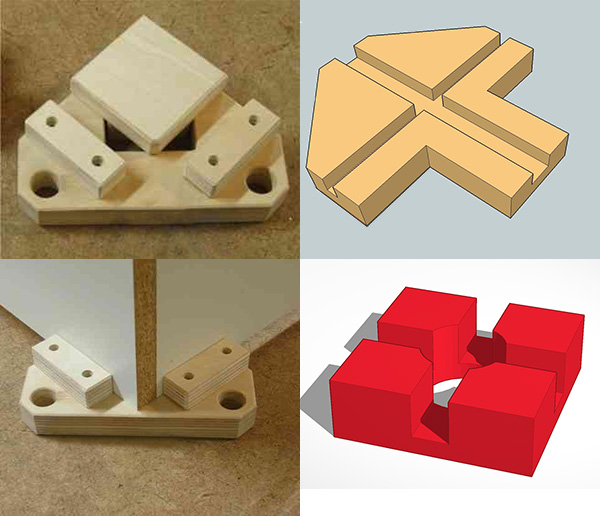I'm practicing building drawers, quickly and on the cheap. The drawers I'm making now have sides that are 3" high x 7/16" actual thickness, decent quality birch veneer plywood.
I know this is really basic, but I'm struggling with the corner joints on the drawers. The reason I'm practicing is ultimately I want to build a few storage cabinets with about 40 drawers total = 160 corner joints I'm going to have to make. I'm trying to come up with a workflow that is both quick and precise. I also really want the joint to be hidden. I'm not too concerned about super high strength.
The relevant tools I currently own are:
- A table saw, one of the cheap but relatively decent Ridgid ones.
- A biscuit cutter, the Makita one.
- A Kreg jig.
- Tons of clamps of various sizes.
- A portable bandsaw with a little table for it, although the miter slots aren't lined up properly with the blade.
- A scroll saw.
- A trim router, hand-held, with a makeshift table. 20000 RPM min speed and terrifying. In the table usually I just end up shooting large wooden projectiles across the room.
- All the basic stuff, drills, hammers, chisels, various hand saws and such.
There's countless ways to join corners in theory but in reality I'm actually really having a hard time with even the most basic stuff. The techniques I've tried so far have been mostly successful but not quick or easy -- at least not as quick and easy as I'd like them to be -- and also pretty error prone:
- Butt Joints:
- Using glue only, do the clamp-a-square-thing-into-the-corner technique. I put wax paper in the corner to keep the square from being glued to the piece. Problems:
- It's actually very difficult to keep the joint flush and straight while at the same time somehow positioning the block in the corner, putting two clamps on, and not getting glue everywhere. It's really easy for this joint to become not flush any more.
- It's impossible to wipe wet glue off the interior corner, and it tends to squeeze out and be forced along the wax paper and make a big mess.
- Current best: Using glue only, use these 90 degree clamps, one on top and one on the bottom. This is the best technique I've found so far, but it's still pretty rough. Problems:
- It's tough to position the wood in the clamps so that the outside remains perfectly flush. It's totally doable, but takes more finesse than I want it to. It's a many-step process to get everything set up to be flush.
- I only own 8 of these clamps, which means I can only glue up 1 drawer at a time. At $10 each I'd need to buy another $80 of hardware that I wouldn't really need for any other project just to raise my throughput to 2 drawers at a time.
- Biscuits for alignment: Should work in theory. Problems:
- In practice it's very difficult because despite how often I've practiced with this thing, I have yet to discover a good technique for perfectly straight, positioned cuts on the side that you have to cut into the face of (i.e. the end-grain cut is easy, but I really have a hard time keeping the biscuit cutter straight and properly positioning the biscuit on the face cut).
- It's tricky to design everything so that the biscuit doesn't interfere with the dado I've cut for the drawer's slide track.
- Line up the butt joint, drill pilot holes, glue, and screw it together. Then remove the screws after the glue dries and plug the holes. The main problem with this is it takes forever, and still has the same difficulties holding the joint true and flush.
- Pocket holes: The Kreg jig just doesn't do that well with 7/16" thick material, it's a bit too thin, and the plywood tends to get torn apart. Plus, same alignment difficulties when driving the screws in. Also I have to use these just as temporary screws, because since the material is so thin the screw heads hang out past the face.
- Nails to temporarily hold wood in place. Same set of problems as above + lots of bruised fingers. And the nails end up permanent, really hard to pull nails back out without tearing up the pieces. I don't want the nails to be visible on the outside.
- Drill holes, insert dowels: Aesthetically acceptable but a huge pain and has same alignment issues as just putting screws in.
- Using glue only, do the clamp-a-square-thing-into-the-corner technique. I put wax paper in the corner to keep the square from being glued to the piece. Problems:
- Rabbetted corners: I can't actually figure out how to cut these quickly. I can do it on the table saw but making the two rabbets line up properly is way harder than it sounds. Also this doesn't really gain me anything at all in terms of speed or alignment ease over gluing the butt joints.
- Tongue-and-groove variants: No idea how to cut these easily. Same difficulty getting the tongue and groove to line up properly as with the rabbets. Plus the plywood starts to become very weak and the thinner bits tend to snap off during assembly.
So how can I do this, in reality, given that e.g. my grandfather hasn't been passing on his mystical woodworking knowledge to me for the last 35 years of my life? I'm just a normal person, not one of those legendary woodworking samurais who can hand-cut perfect dovetails in 5 seconds, while drunk, with their eyes closed.
I'm really struggling to find a quick and precise technique given my current set of tools and fine motor control skills. It's easy with large pieces but the 3" x 7/16" plywood seems to be introducing new challenges.
